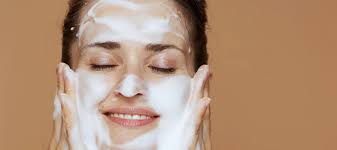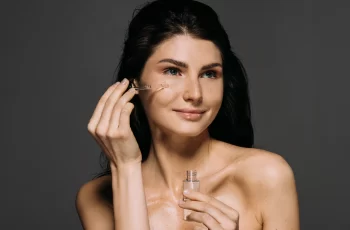Do I Need To Wash My Face After A Sheet Mask?
The main point of a sheet mask is to help hydrate the skin. While we recommend taking the sheet mask off after 20 minutes of usage, this doesn’t mean you have to wash your skin, as the ingredients can carry on taking effect afterwards, as the serum sinks into the skin.
Just like if you were to add moisturiser to the skin, you wouldn’t wash it off straight afterwards. The ingredients have a long lasting effect and take time to completely sink into the skin and to take full effect. On the other hand, if it’s the evening, you could still apply a night cream.
This is a regularly spoken about topic and the main reason for this is because a traditional mask, using ingredients like mud, must be washed off completely after use. However, sheet masks are very much a different kettle of fish, meaning it is absolutely fine to leave on the skin, in order to reap all the benefits.
Just like sheet masks, you also don’t need to wash off eye masks, as these contain a large amount of serum, which will work like a moisturiser on the skin.
Regardless, we still recommend reading the individual pack to ensure you gain optimal results, as all products are different and have different ingredients included.
What About Before I Apply The Sheet Mask?
Before you apply the mask, you need to use an exfoliator, to clean any pollutants and excess oil from the top layer of the skin, as well as opening the pores. To understand the importance, you need to look at the three layers of the skin…
The Epidermis – This is the outer layer of skin that you need to clean through exfoliation. This is what creates our skin tone.
The Dermis – This is what the sheet mask will clear, as it contains hair follicles and sweat glands, as well as connective tissue.
The Hypodermis – Made up largely of fat and connective tissue, this is the deeper layer of subcutaneous tissue.
With this in mind, we need to ensure the sheet mask will work by clearing any oil and dirt from the epidermis and opening up the pores. The sheet mask simply can’t get through to take effect if you haven’t cleared off all the dead skin cells trapped on the surface level, therefore if you really want to see the benefits of applying a sheet mask, you need to take the preparation seriously.
So which exfoliation technique do I use?
There are an incredible amount of exfoliation techniques available to you, such as chemical exfoliation, which is largely utilising AHA’s or BHA’s. alpha hydroxy acids (AHA), sourced from fruits, nuts and sugars (e.g. citric acid, mandelic acid or glycolic acid). Beta Hydroxy Acid are great at penetrating the oils that collect on the skin, as well as clearing follicles of dead skin cells. An example of one is salicylic acid.
You can also try mechanical exfoliation, using some form of tool. If you do decide to use this, be cautious of which one you opt for, as you do not want one that is too abrasive and can cause skin irritation, such as crushed fruit pits.
You will now find that microbeads, which used to be commonly used, are now banned in the UK and most of Europe. This is because the incredible damage they do to the environment, as they filled the ocean. This is a huge positive and something people campaigned for over a significant period of time.
At the end of the day, whether you use a sharp grain or a deep pore machine, you should most definitely utilise this in your beauty regime.
What Next?
There is one final step before you apply the sheet mask. You need to heat your face to open up the pores. You can either do this by splashing on some warm water, or you could consider steaming.
To do a steam facial, the most common method involves boiling some water and then pour the boiled water into a bowl, drop your head over the bowl and wrap a towel over your head. This will create a sort of tent, so that the steam stays in and helps to perfectly open the pores. I would recommend keeping your eyes closed, as otherwise it can be quite uncomfortable. I’d also recommend breathing deeply.
Make sure to keep a gap between your face and the water and be careful of splashing.
Don’t miss out on more skincare tips and expert advice over on our YouTube channel! Come and find us on The Green Sofa by hitting the subscribe button, you won’t regret it!
DQH Knowledge drop: In your 20s, your skin cell turnover decreases. (Cell turnover is a key component in keeping your skin youthful.) You know what else slows down? Your collagen production. Starting in your 20s, collagen decreases by about 1 percent per year. Should you want to prevent fine lines and wrinkles, start by eliminating behaviors that contribute to premature aging. “If it’s bad for you, it’s bad for your skin,” says dermatologist Michel Somenek.
“Cigarette smoking reduces blood flow to the skin and causes premature wrinkling and a dull skin texture. Making the repeated pursed motion to inhale can also cause smoker’s lines. Alcohol and recreational drugs are toxins for the skin that damage its cellular structure and DNA,” Somenek tells us. “The faster you eliminate vices while you are young, the better chance your skin and body have to recuperate.” Also, adopting an anti-aging routine in your 20s is key. After all, the best offense is a good defense. We spoke to Somenek and experts Joshua Ross and Audrey Kunin to find out more.
Keep reading for the best anti-aging products for your 20s, according to skincare professionals.
Sunscreen
“We all know that the sun is the number one cause of skin aging and starting the prevention in your 20s is very important,” Ross says. “The majority of your sun damage won’t start to appear until you’re in your 30s, so don’t wait until you see it surface or you’ll be behind the curve. Stay ahead of it with a good-quality zinc-based sunscreen worn daily.”
Farmacy Green Defense Daily Mineral Sunscreen
An invisible sunscreen with SPF 30, plus botanical extracts meant to protect skin with tons of antioxidants. Bonus: It’s clean and fine to use under makeup.
Bareminerals Complexion Rescue™ Tinted Moisturizer Broad Spectrum SPF 30
Although we recommend you use your SPF and moisturizer separately, we also understand moments when you don’t have time or energy for that extra step. For those times, this bareMinerals moisturizer is a great thing to have on hand.
Vitamin C Serum
“A great introduction to anti-aging is to start with a vitamin C serum in your morning skincare routine,” Ross says. “It’s a powerful antioxidant that will neutralize free radicals and brighten the skin.” He adds that it’s a great way to counteract the effects of the sun’s harmful rays, which, as previously mentioned, are among the biggest causes of premature aging.
Drunk Elephant C-Firma™ Vitamin C Day Serum
The Drunk Elephant C-Firma is a lightweight serum that promises to give skin a glow by combining the brightening powers of vitamin C with ferulic acid, l-ascorbic acid, and vitamin E. The included sodium hyaluronate is meant to replace hydration loss, so you shouldn’t have to deal with any irritation.
Sunday Riley C.E.O. Rapid Flash Brightening Serum
This potent serum is jam-packed with vitamin C (15 percent, to be exact), which means it’s a potential superstar at both brightening skin and dousing it in antioxidants.
Peptides
Using peptides on your skin has many benefits, says Somenek. “The skin barrier is what defends the body against pollution, UV rays, bacteria, and toxins. It can be damaged by several everyday factors. Using topical peptides aids in building a stronger barrier,” he says. “Peptides comprise elastic fibers, which are a type of protein. These fibers help to make skin appear taut and firm. Peptides can also help repair damaged skin, relieve inflammation, and even out skin tone. Some peptides can kill acne-causing bacteria that is common in 20-somethings.”
Kunin agrees, saying, “Peptides are an excellent entry point for supporting collagen.” She recommends looking for face and eye treatments that contain these collagen-boosting powerhouses.
Charlotte Tilbury Magic Eye Rescue Cream
This Charlotte Tilbury super-emollient eye cream has a base of coconut oil and shea butter (read: it’s incredibly hydrating). Botanicals plus peptides are meant to help reduce dark circles and boost collagen, respectively.
This creamy moisturizer serves up potent collagen-boosting peptides and pycnogenol, and antioxidant-rich vitamin C. “Instead of sitting on top of the skin, peptides penetrate the outer layer so they go deep. The ‘signals’ they send tell the cells to produce elastin and collagen, which are needed for youthful-looking skin,” explains Somenek.
At-Home Peel Pads
Remember that skin cell turnover fiasco we talked about earlier? One way to help support it is by exfoliating. “Exfoliation is important to help keep skin fresh and luminous,” Kunin says. She recommends using at-home peel pads as an easy and effective way to exfoliate.
“The goal in your 20s is to fight the slowing pace of cell turnover. It is wise to use products that gently exfoliate, yet still remove oil and other impurities. Products that have Alpha Hydroxy Acids (AHA) or Beta Hydroxy Acids (BHA) are a good choice.”
According to Somenek, you should only exfoliate two to three times a week. “People of all ages are guilty of over-exfoliating and that can be too much of a good thing,” he says.
Dermadoctor Kakadu C Intensive Vitamin C Peel Pad
A few swipes of this Derma Doctor powerful peel pad promise to leave your skin glowing and smooth, thanks to the seven (yes, seven) types of chemical exfoliants, including AHA and BHA. It also contains vitamin C via Kakadu plum extract for added brightening and antioxidant protection.
KEY INGREDIENTS Kakadu plum extract is sourced from the Kakadu plum, a fruit grown in northern Australia. It contains vitamin C, which restores the skin’s natural barrier, increases collagen production, and soothes irritation.
Dr. Dennis Gross Skincare Alpha Beta® Universal Daily Peel Pads
These are the gold standard of peel pads, with a cult following and over 900 five-star reviews on Sephora. They’re easy to use and contain a blend of anti-aging exfoliating acids.
Emollient Night Cream
“In your 20s, you need to start upping the hydration in your skincare routine. You may have been cautious of over-moisturizing because of acne in your teens, but as you enter your 20s, your skin transitions and becomes drier,” Ross says. “I recommend an emollient night cream added into your evening skincare regimen.”
“Twenty-somethings need to make sure that they are not using creams that will clog their pores and cause excess oil production,” says Somenek. Opt for non-comedogenic products.
Cerave Skin Renewing Night Cream
One great choice is the CeraVe Skin Renewing Night Cream, which is a non-comedogenic night cream that leaves skin soft and glowy. It combines the moisturizing powers of ceramides and hyaluronic acid.
RoC Retinol Correxion Max Hydration Creme
“The best night cream ingredients contain retinol, benzoyl peroxide, and/or salicylic acid or hyaluronic acid. The goal is to moisturize, yet remove excess oil,” says Somenek. This Roc Retinol Correxion cream fits the bill as it contains both hyaluronic acid and retinol so it promises to moisturize while also being non-comedogenic.



